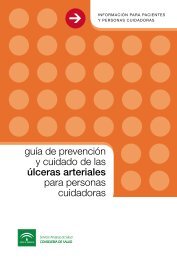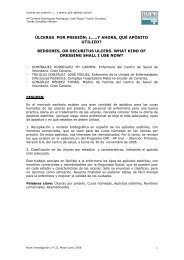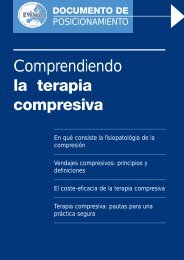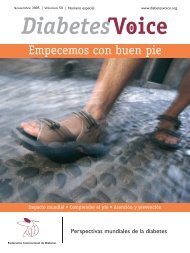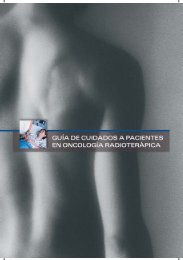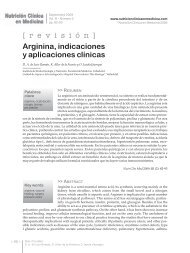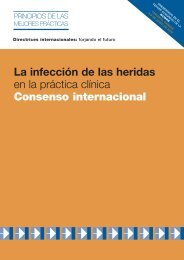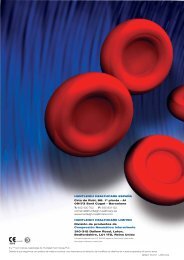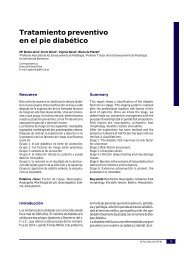Descargar - Úlceras.net
Descargar - Úlceras.net
Descargar - Úlceras.net
- No tags were found...
You also want an ePaper? Increase the reach of your titles
YUMPU automatically turns print PDFs into web optimized ePapers that Google loves.
124 ■ PIE DIABÉTICOance companies only approve HBOT treatmentin the Diabetic Foot ulcers class III orgreater (Wagner classification).Table IEvidence-based indicationsfor hyperbaric treatmentArterial gaseous embolismCarbon monoxide (CO) poisoningClostridial myonecrosis (Gaseous gangrene)Crush-lesions, compartimental syndrome andacute traumatic ischaemic lesionsDecompression sickness (diving acident)Central retinal artery occlusionWound-healing optimization in chronic wounds(with arterial insuffiency)Severe anemiIntracranial abcessNecrotizing soft-tissue infectionsRefractory osteomyelitisRadiation induced lesions (soft tissue and bonenecrosis)Compromised grafts and flapsThermal burns (acute phase)Sudden neurossensorial idiopathic hearing lossIn the light of the ten physiological basicprinciples enumerated above, additionalHBOT utilizations may be hypothesized.Several multicenter randomized trials arecurrently taking place, which might add someindications to this list. Other reports exist indiverse pathologies where a beneficial rolehas been attributed to HBOT but cannot findexplanation in these same principles. Thesereports must be considered regarding theirlevel of the scientific evidence.CONTRAINDICATIONSThe only absolute counter indication forHBOT is a untreated pneumothorax (18).Several relative counter indications have beenreported (10), which require careful evaluationby the hyperbaric physician before initiatingtreatment.Table IIContraindicationsfor hyperbaric treatmentRegular medications: doxorubicin, cisplatin, disulfiramor mafenide acetateAcute superior respiratory infection (equalizationdifficulties)Pulmonary emphysemaPrevious thoracic surgeryPregnancy (unknown effects)Previously, HBOT was counter indicatedin patients with neoplasms because of thehigh risk of tumor expansion due to angiogeniceffect of the treatment. However, a synergiceffect has been reported betweenchemotherapy and increased tumor oxygenation,with improved clinical response to theoncologic treatment (19). This is still an experimentalfield and the patient should be awareof the risks.ADVERSE EFFECTSOxygen is toxic in excessive doses. As inwith any medication, potential side effectsmust be accounted when prescribing oxygentherapy, especially in a hyperbaric environment.Oxygen toxicity may appear in twoforms (10).The acute form, more visible, is also easierto resolve and is known as the Paul Berteffect. It is characterized by central nervoussystem toxicity at high PaO 2. The sessionassistant must be alert for the alert signs (vertigo,irritability, facial muscle tremors, dyspnoea,nausea or vomiting, blurred or tunneledvision) that usually precede a tonic-clonicseizure (10). Seizure treatment is based onadministrating atmospheric air. HBOT protocolsare programmed to avoid this kind oftoxicity.The chronic form, also known as theLorrain Smith (10) effect is more concerningbecause of the insidious and eventually irreversibleevolution it may assume. Pulmonary





